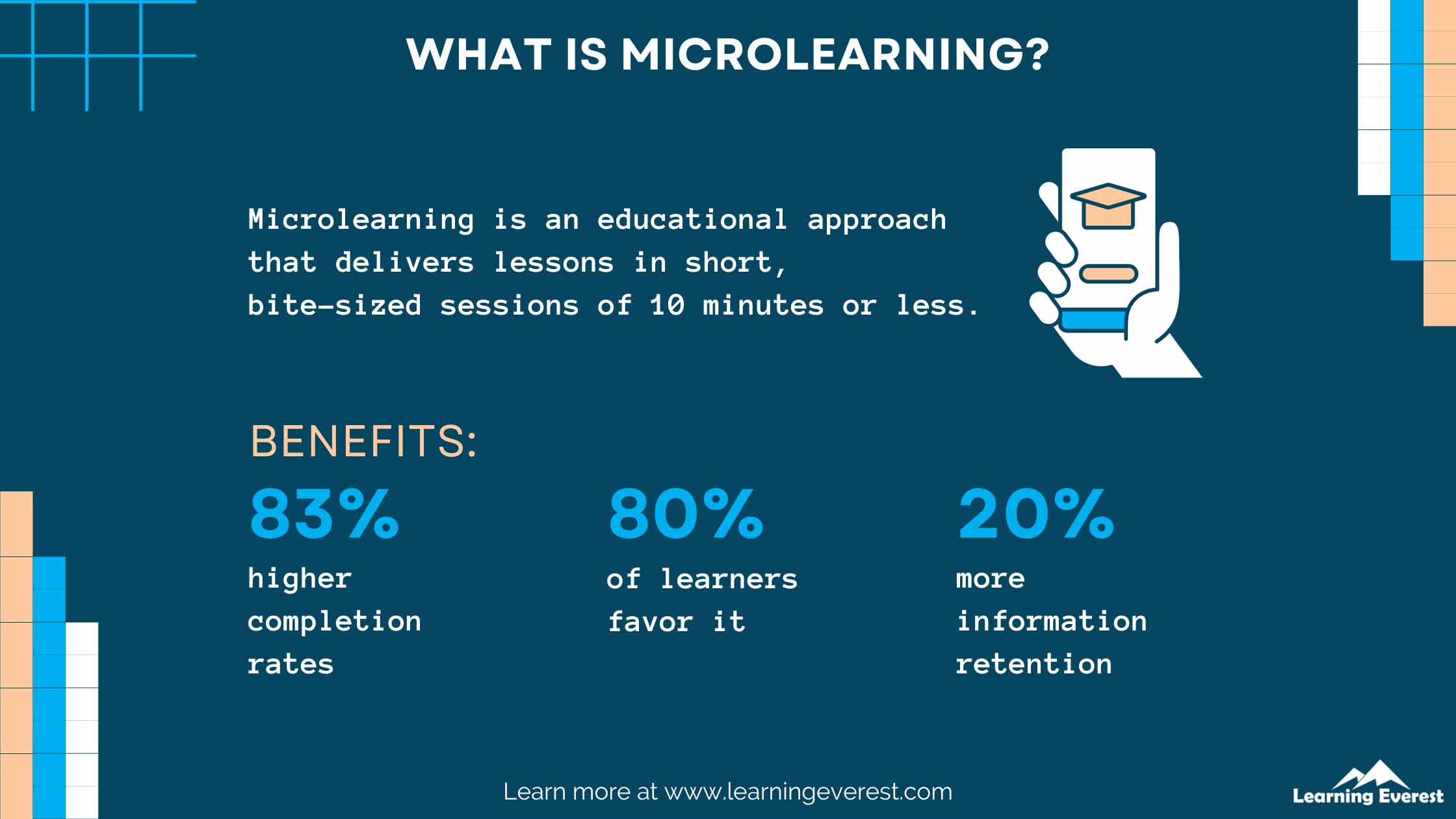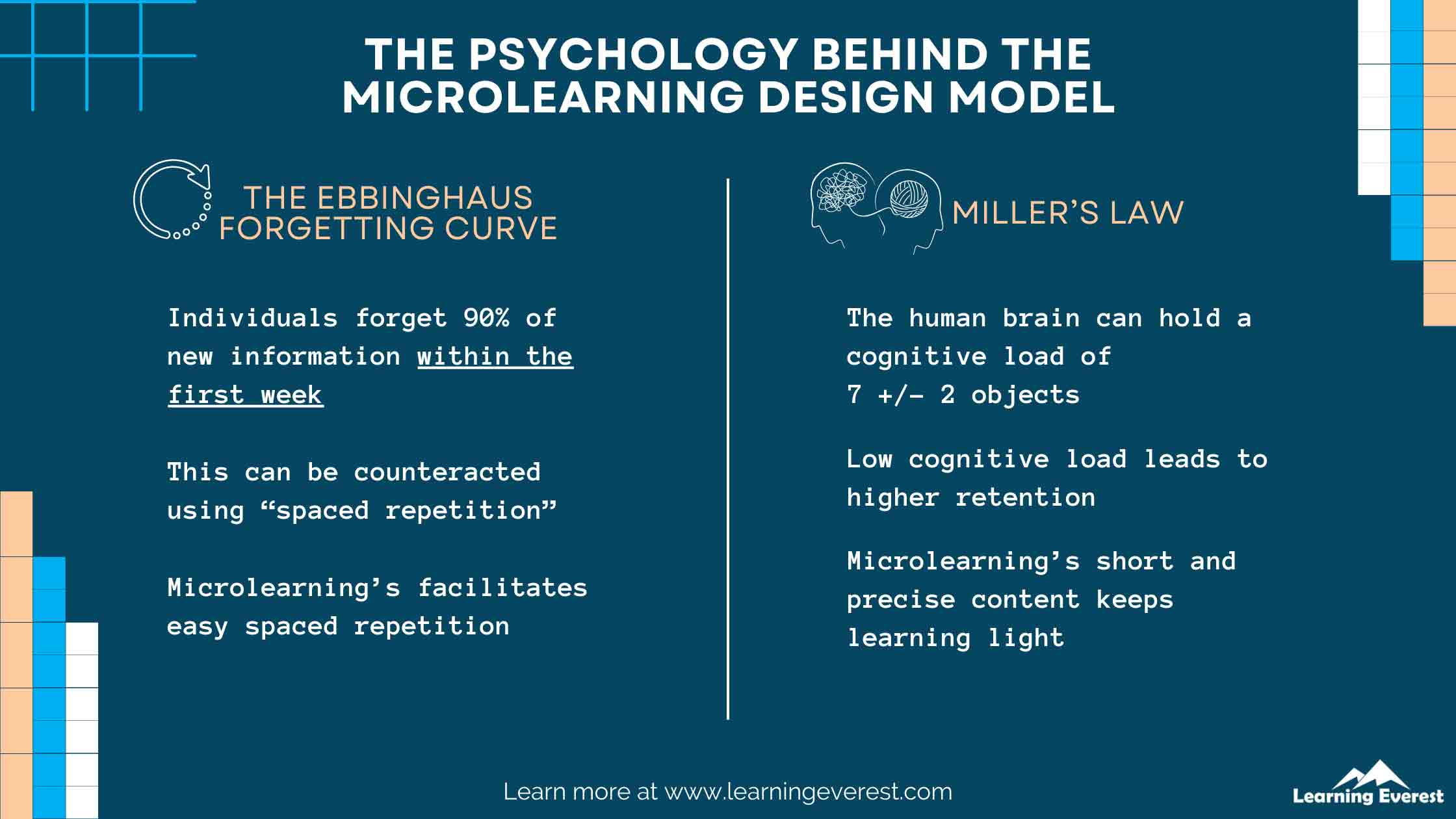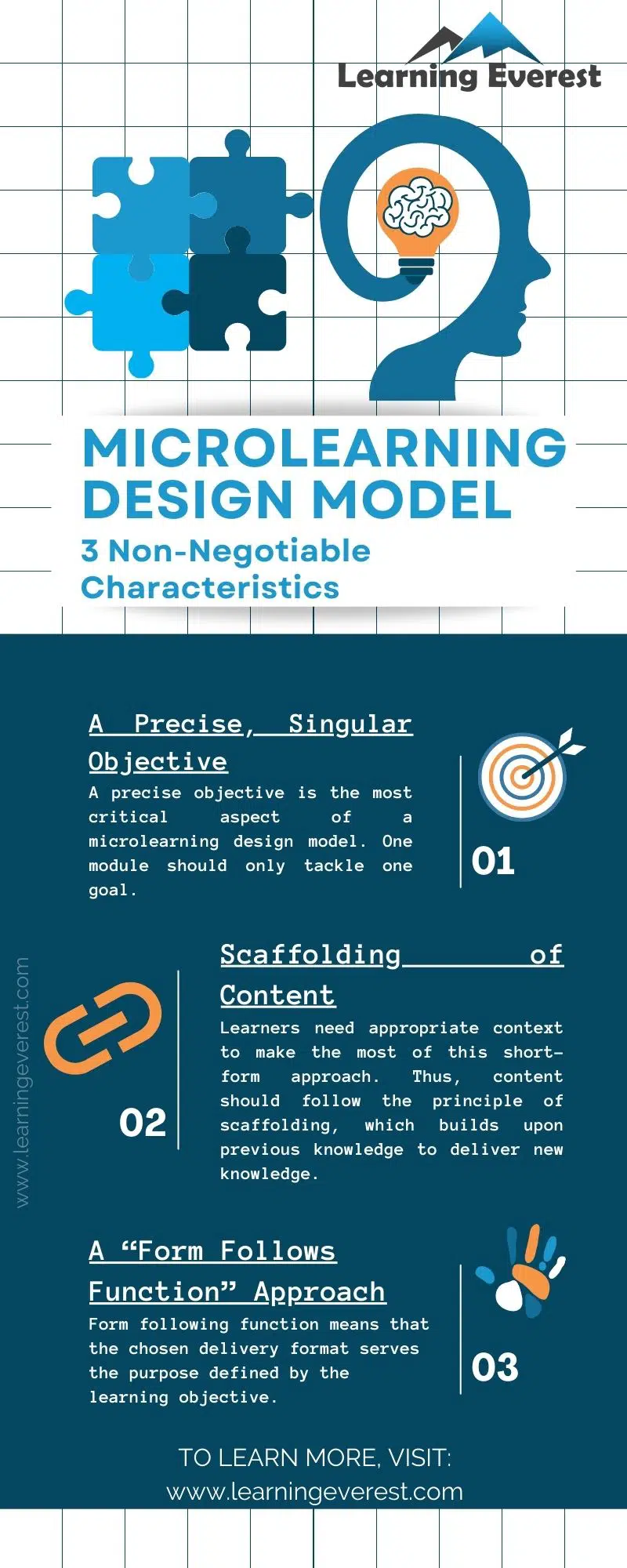The microlearning design model aims to provide learning in small, focused chunks. It is rooted in psychological principles that reduce the cognitive load on the learner’s mind to maximize retention.
Table of Contents
- Modelo de diseño de microaprendizaje: características explicadas
- The Psychology and Brain Science Behind the Microlearning Design Model
- Best Use Cases of the Microlearning Design Model
- 3 Non-Negotiable Characteristics of the Microlearning Design Model
- Infographics
- Knowledge Check!
- Preguntas frecuentes (FAQ)
- ¿Qué es el diseño instruccional de microaprendizaje?
- ¿Cómo hacer un curso de microaprendizaje?
- ¿Qué son los ejemplos de contenido de microaprendizaje?
- ¿Por qué funciona el microaprendizaje?
Microlearning Design Model: Features Explained
Due to becoming a fad word in recent years, microlearning and its complexity are often watered down. The focus usually ends up on the “micro” aspect of the approach. While that is the long and short of this model, much more nuance to it gets overlooked.

What is Microlearning?
Microlearning design models derive their efficacy from the following features:
- Precise, to the point, and short content. Microlearning modules condense topics into their bare-bones details for brevity.
- Learning that is weaved into the natural flow of work. Since corporate employees are the primary target audience for microlearning, this design model is shaped to facilitate easy learning between pockets of work.
- Course delivery is rooted in brain science to maximize retention and engagement. Microlearning utilizes well-established learning principles to ensure courses grab learners’ attention, engage them, and become a part of their long-term memory. They do so by reducing cognitive load.
- Guided by business goals and heavily focused on achieving prescribed learning outcomes. Microlearning design models do not compromise on attaining learning outcomes. Like long-form course delivery, microlearning is goal and outcome-oriented and uses various tools to meet them.
- On-demand availability. Learners can access microlearning modules and courses at their convenience and as per their needs. They are usually available on Learning Management Systems (LMS). Learners simply need to log in and search for what they need or pick up where they last left off. They can learn during breaks and downtime, while traveling, etc.
The Psychology and Brain Science Behind the Microlearning Design Model
The microlearning design model is based on two critical psychological principles of memory – Ebbinghaus’ Forgetting Curve and Miller’s Law.
The Ebbinghaus Forgetting Curve is a graphical model of forgetting. German psychologist, Hermann Ebbinghaus, discovered that individuals forget 90% of what they have learned within the first week of encountering the information. Out of this, 50-70% of the forgetting happens in the first 24 hours itself. He introduced spaced repetition to mitigate the effects of the forgetting curve. In spaced repetition, learners re-engage with content at fixed, psychologically proven intervals to refresh their memories and push it into the long-term memory.
The second principle that guides microlearning is Miller’s Law. This law states that an individual can focus on 7 plus or minus 2 objects in their short-term memory at any given moment. In other words, this is the extent of the cognitive load the human brain can effectively bear. However, not all objects in the short-term memory make it into long-term memory. The process of information becoming a part of long-term memory is consolidation. Effective consolidation happens when the cognitive load is low, i.e., when the person is dealing with fewer stimuli.
You can probably associate these principles with the features of the microlearning design model mentioned above.
Microlearning utilizes the 7 plus or minus 2 rule of Miller’s law to provide short and precise content and allows learners to consolidate information. On-demand availability provides opportunities to revise. Instructional designers often incorporate spaced repetition intervals into the course. Additionally, the LMS also provides spaced cues to revise.

The Psychology Behind the Microlearning Design Model
Best Use Cases of the Microlearning Design Model
Microlearning’s most significant advantage is how well it fits the attention patterns of learners in the digital age. Instructional designers heavily bank on its adaptability to mobile learning. Microlearning courses are commonly available on mobile devices. However, despite its broad utility, microlearning is certainly not suited to all information formats. Sometimes, a microlearning design model is best used in combination with other instructional design approaches.
When it is not possible to deliver information purely via microlearning, instructional designers can turn them into tools to revise, reinforce, and assess.
Nonetheless, the training areas where microlearning shines are:
- Product knowledge – microlearning is effective when it comes to factual information. Product knowledge is one such area. Using microlearning in various formats to familiarize employees with product features is a quick and efficient way to build familiarity with the company’s product catalog.
- Sales skills – this is an area where product knowledge comes in extra handy. Additionally, microlearning can teach salespersons tips and tricks on how to open and close sales using persuasive introductions and serve as a tool for assessment and self-testing.
- Customer support – Similar to sales skills, communication skills training, standardized opening and closing statements, company terminology for addressing customers, etc., is information microlearning is effective at teaching.
- Safety protocols – These are another set of standard and precise procedures that can be delivered using microlearning.
To summarize, when it is the only course delivery format being used, hard skills and procedural knowledge are the best candidates for a microlearning design model.
3 Non-Negotiable Characteristics of the Microlearning Design Model
Now that you have a fair idea of microlearning and when to use it, it is time to look at how its implementation when designing a course.
Like all other instructional design approaches, putting a microlearning course together starts with setting objectives. These are learning outcomes that capture how to attain the business’ larger goals. Once these are set, the actual course design begins.
A microlearning based design model always has the following characteristics:
- A Precise, Singular Objective: A precise objective is the most critical aspect of a microlearning design model. One module should only tackle one goal. This is what lends precision and brevity to microlearning by reducing cognitive effort.
- Scaffolding of Content: Learners need appropriate context to make the most of this short-form approach. Thus, content should follow the principle of scaffolding, which builds upon previous knowledge to deliver new knowledge. A lengthy introduction is unnecessary; just a few keywords do the trick. The objective is not to leave the learner hanging.
- A “Form Follows Function” Approach: Form following function means that the chosen delivery format serves the purpose defined by the learning objective. For example, when training salespeople about a new product’s features, showing them an infographic with pictures and text about the subject would help them visualize and verbally encode all the new information in one go, making it easy for them to relay that information to customers later.
As long as a microlearning course fulfills these non-negotiable characteristics, they are very fluid in presenting the information.
Videos, animations, drag and drop activities, gamified quizzes, fill in the blanks, interactive PDFs, presentations, etc., can all be used, depending on the learners. Microlearning is a great asset for corporate learners when used in the proper contexts.
Infographics

Microlearning Design Model
Knowledge Check!
Frequently Asked Questions (FAQs)
What is Microlearning instructional design?
The microlearning design model aims to provide learning in small, focused chunks. It is rooted in psychological principles that reduce the cognitive load on the learner’s mind to maximize retention.
How do you make a microlearning course?
A microlearning based design model always has the following characteristics:
- A Precise, Singular Objective
- Scaffolding of Content
- A “Form Follows Function” Approach
What are microlearning content examples?
Videos, animations, drag and drop activities, gamified quizzes, fill in the blanks, interactive PDFs, presentations, etc. can all be used, depending on the learners. Microlearning is a great asset for corporate learners when used in the right contexts.
Why does microlearning work?
The microlearning design model is based on two critical psychological principles of memory – Ebbinghaus’ Forgetting Curve and Miller’s Law.
Microlearning utilizes the 7 plus or minus 2 rule of Miller’s law to provide short and precise content and allows learners to consolidate information. On-demand availability provides opportunities to revise. Instructional designers often incorporate spaced repetition intervals into the course. Additionally, the LMS also provides spaced cues to revise.





